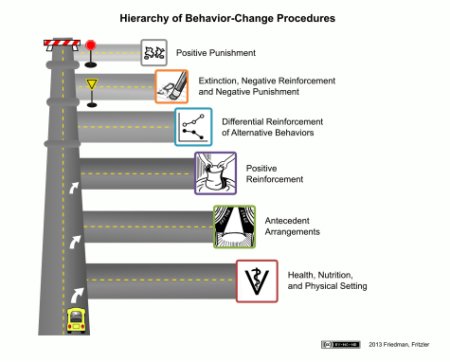I was one of more than 500 trainers from across the globe who convened on Dearborn, Michigan in March for the Karen Pryer Clicker Training Expo. It was a phenomenal opportunity to learn from some of the best trainers and behaviorists whose focus is on modifying behavior in the most positive way. What also made the weekend special for me was the chance to see my very first teacher and long time mentor, Dr. Susan Friedman (who pioneered the use of Applied Behavior Science to the care and training of captive and companion animals). In one of her lectures, ‘Effectiveness Is Not Enough’, Susan reminded us to make a habit of two things: to HELP or at least to DO NO HARM. She also talked to us about the Humane Hierarchy.
In one of her lectures, ‘Effectiveness Is Not Enough’, Susan reminded us to make a habit of two things: to HELP or at least to DO NO HARM. She also talked to us about the Humane Hierarchy.
Ask yourself…
When a dog snarls at youth on skateboards and is held down while they continue to skateboard in small circles around him until he stops reacting, is that the least intrusive, effective solution for the problem situation, or, is it ethical??
When a dog struggles to escape a comb held close to his face and is restrained at the scruff while combing his muzzle until he stops resisting, is that the least intrusive, effective solution for the problem situation, or, is it ethical??
When a dog lunges, growls and barks while on leash while another dog is around and is restrained until he stops those behaviors, is that the least intrusive, effective solution for the problem situation, or, is it ethical??
What do all of these approaches have in common?
In each of these circumstances, the frequency and/or intensity of a behavior is decreased in order to remove or get distance from an aversive stimulus that is added to the environment. Scientifically this is called positive punishment.
Does this work to change behavior? Unfortunately, it does, and every time it does the teacher is reinforced for using it.
Susan has reminded me time again the cost of using this approach.
Sure, you may have changed behavior but punishment can cause apathy, generalized fear, counter aggression, and escape/avoidance. Punishment does not serve to ‘teach’ the animal what you want him to do instead and most certainly does not teach the teacher how to help the animal succeed. It requires escalating intensity to maintain suppression. It is actually a double negative in that it both it is a big withdrawal from the positive reinforcement bank while also being highly aversive. AND, for all of this, the teacher can become associated with those aversives.
In fact, in several of the cases above what has happened is called ‘learned helplessness’ as a result of flooding. Flooding is a form of training in which the animal is exposed to an aversive stimulus with no possibility of escape until the stimulus no longer arouses anxiety or fear. But can you imagine the level of anxiety and discomfort it causes the animal in the process? It is either sink or swim basically. In many cases flooding only serves to make the animal more anxious and forces it to adopt different coping mechanisms to ensure safety and survival.
Learned helplessness occurs when an animal is repeatedly subjected to an aversive stimulus that it cannot escape. Eventually, the animal will stop trying to avoid the stimulus and behave as if it is utterly helpless to change the situation. Even when opportunities to escape are presented, this learned helplessness will prevent any action.
Susan teaches a Humane Hierarchy when it comes to behavior change strategies. As much as possible, animals should be empowered to use their behavior to control significant events in their life. Read more: Dr. Susan Friedman: What’s Wrong with this Picture
The Humane Hierarchy is a ranking of training methodologies going from least intrusive for the learner to most intrusive with Level 1 being the most socially acceptable and giving the animal the highest amount of control. “The overwhelming majority of behavior problems can be prevented or resolved with one or more strategies represented in Levels 1 to 4,” she wrote in a paper.
The levels include:
Level 1: Distant Antecedents – address medical, nutritional and physical environment variables.
Level 2: Immediate Antecedents – redesign setting events, change motivations, and add or remove discriminative stimuli (cues) for the behavior.
Level 3: Positive Reinforcement – contingently deliver a consequence to increase the probability that the right behavior will occur, which is more reinforcing than the problem behavior.
Level 4: Differential Reinforcement of an Alternative Behavior – reinforce an acceptable replacement behavior and remove the maintaining reinforcer for the problem behavior.
Level 5:
- Negative Punishment – contingently withdraw a positive reinforcer to reduce the probability that the problem behavior will occur.
- Negative Reinforcement – contingently withdraw an aversive antecedent stimulus to increase the probability that the right behavior will occur.
- Extinction – permanently remove the maintaining reiforcer to suppress the behavior or reduce it to baseline levels.
Level 6: Positive Punishment – contingently deliver an aversive consequence to reduce the probability that the problem behavior will occur.
Learn more about antecedent arrangement and using it by clicking here.
Learn more about differential reinforcement, by clicking here.
When I train dogs and other animals, I always work to empower them, by teaching them that making a wanted behavior choice will result in a positive consequence. What is an example of how you modified your pet’s behavior in a positive way? I’d love to hear.






